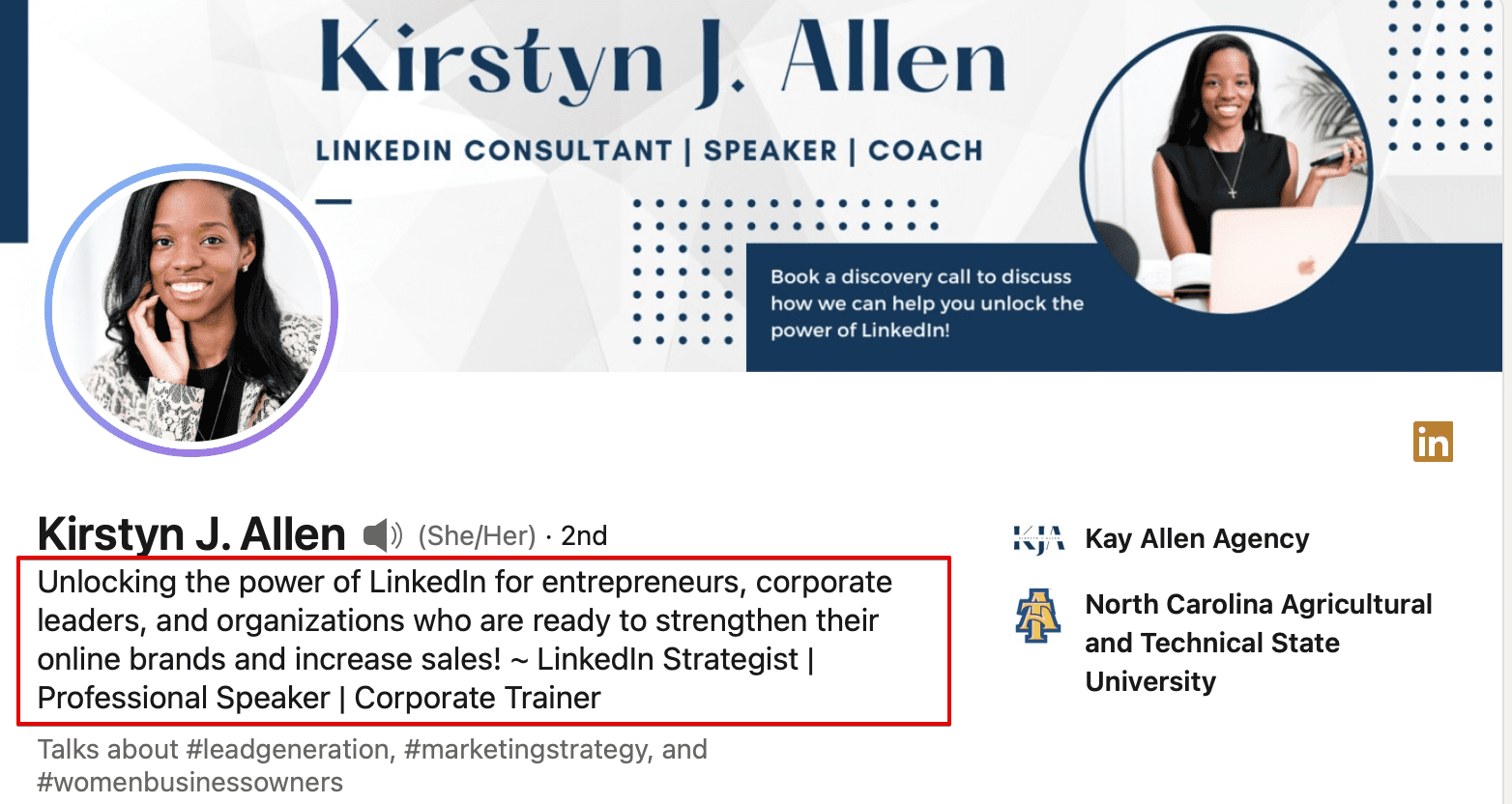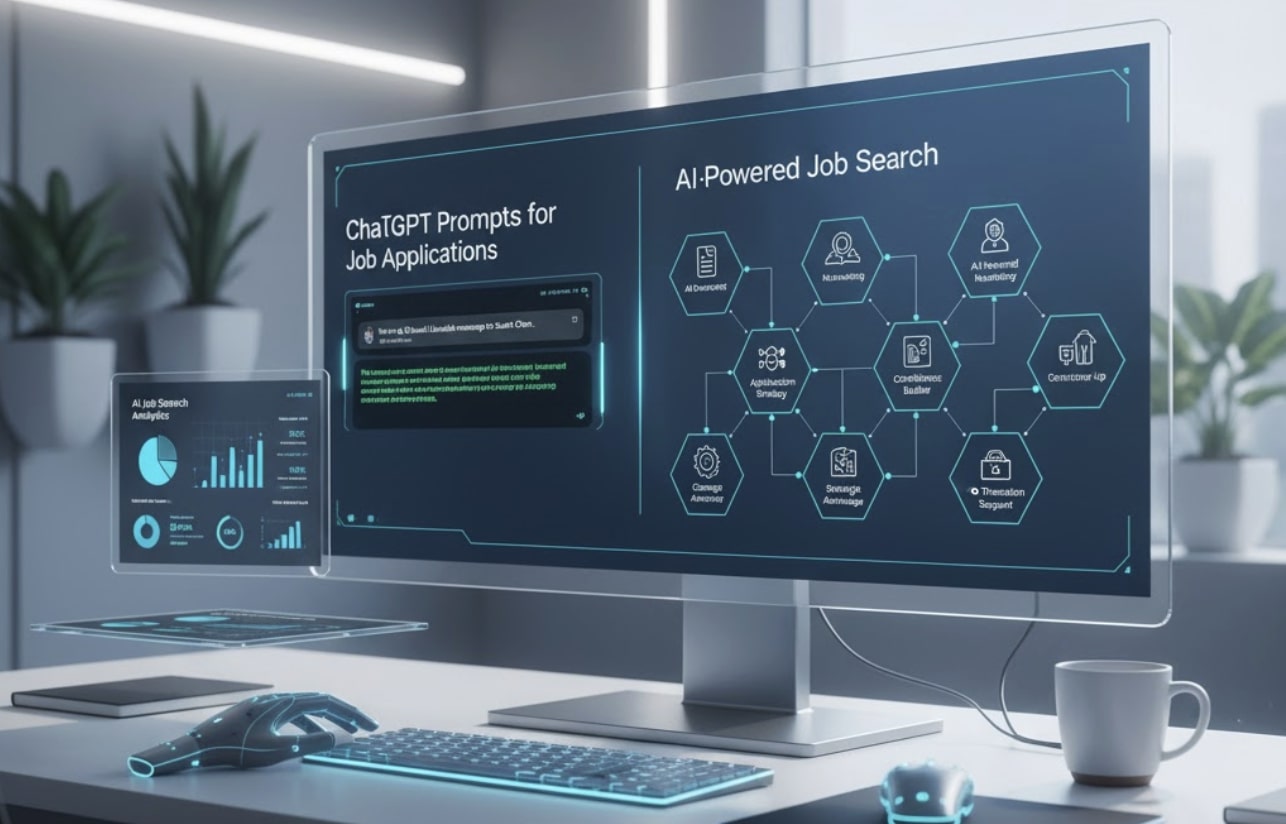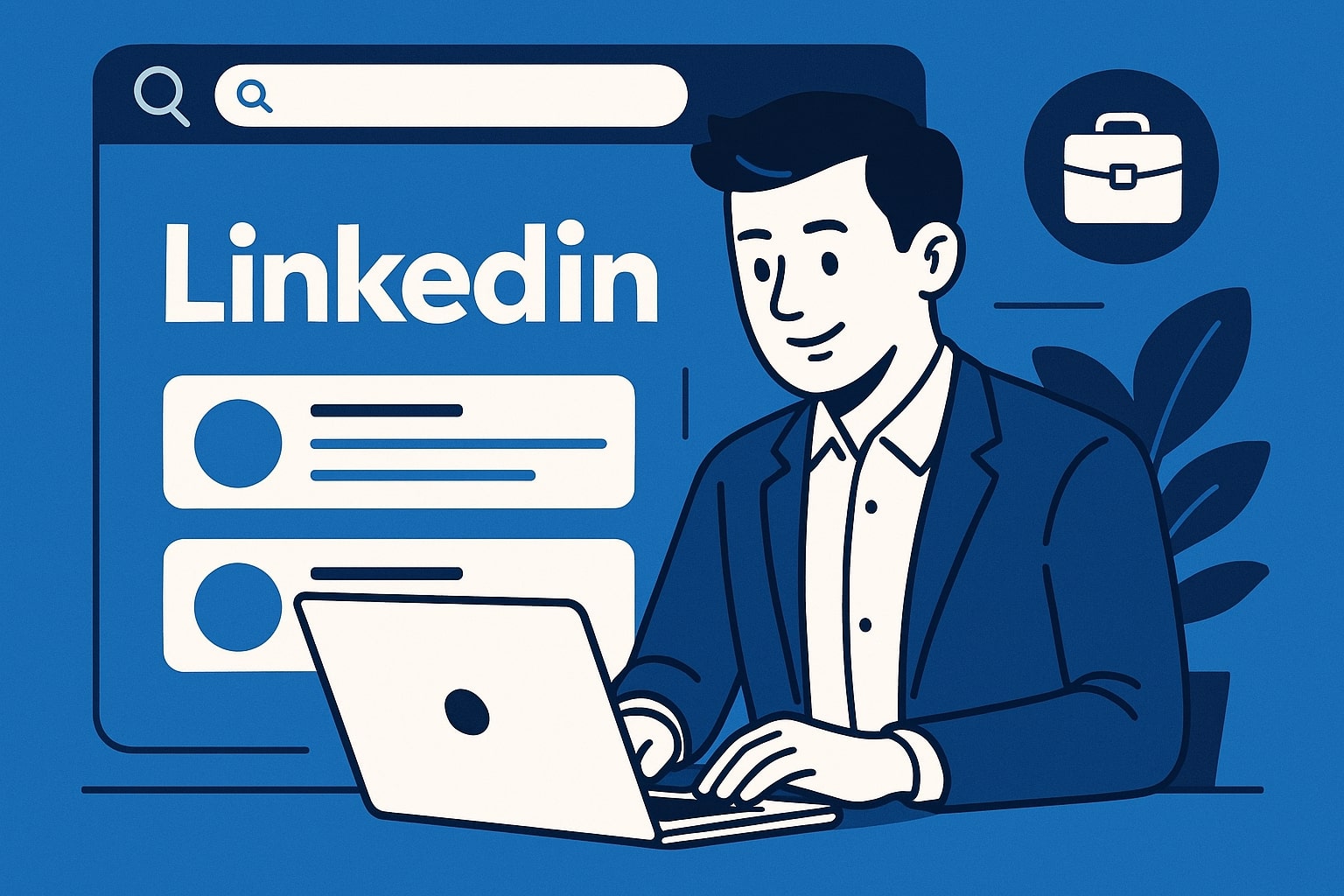Your LinkedIn profile is your digital business card, and in today’s competitive job market, making it stand out is more crucial than ever. With 740 million users on the platform and recruiters spending just 6 seconds reviewing each profile, you need every advantage possible.
Artificial Intelligence has revolutionized how we optimize professional profiles, offering data-driven insights that can transform your LinkedIn presence from overlooked to irresistible. This comprehensive guide reveals how to leverage AI tools and strategies to create a profile that attracts recruiters, builds meaningful connections, and accelerates your career growth.
1. Understanding AI’s Role in LinkedIn Profile Optimization
LinkedIn itself uses AI algorithms to determine profile visibility and match candidates with job opportunities. Understanding these systems gives you a strategic advantage in profile optimization.
The platform’s AI considers multiple factors when ranking profiles in search results. These include keyword relevance, profile completeness, and engagement levels. By aligning your optimization strategy with these algorithmic preferences, you significantly increase your chances of being discovered by the right people.
- Algorithm Alignment. LinkedIn’s AI prioritizes profiles with relevant keywords, complete sections, and active engagement patterns.
- Data-Driven Insights. AI tools analyze thousands of successful profiles to identify patterns that lead to better visibility and opportunities.
- Personalization at Scale. AI enables you to customize your profile elements for different audiences while maintaining authenticity.
- Continuous Optimization. AI-powered analytics provide ongoing feedback to refine your profile performance over time.
Modern AI tools can analyze your current profile against industry benchmarks and suggest specific improvements. They examine everything from headline structure to skill endorsements, providing actionable recommendations based on successful profile patterns in your field.
The key advantage of AI-driven optimization lies in its ability to process vast amounts of data quickly. While manual optimization relies on general best practices, AI provides personalized recommendations based on your specific industry, role, and career goals.
2. AI-Powered Headline Optimization Strategies
Your LinkedIn headline is prime real estate that appears in every search result, connection request, and post you make. AI can help you craft headlines that are both keyword-rich and compelling to human readers.
Traditional headlines often fall flat because they’re either too generic or too focused on job titles. AI-optimized headlines balance multiple objectives: searchability, personality, and value proposition clarity.
✔ AI-Optimized Headline Example
“Digital Marketing Manager | B2B SaaS Growth Specialist | Driving 40% Revenue Increases Through Data-Driven Campaigns | Content Strategy Expert”
This headline works because it includes the primary job title, specialization area, quantifiable achievement, and key skill. AI tools can analyze your background and suggest similar structures tailored to your experience.
Prompt Example for AI Headline Generation: “Create 5 LinkedIn headlines for a [your job title] with [X years] experience in [industry], highlighting skills in [skill 1], [skill 2], and [skill 3]. Include quantifiable achievements and make each headline under 220 characters.”
| Headline Element | Traditional Approach | AI-Optimized Approach |
|---|---|---|
| Job Title | Marketing Manager | Digital Marketing Manager | B2B SaaS Growth Specialist |
| Value Proposition | Experienced professional | Driving 40% Revenue Increases Through Data-Driven Campaigns |
| Skills | Marketing skills | Content Strategy Expert | SEO Specialist | Marketing Automation |
| Keywords | Generic terms | Industry-specific, searchable terms |
AI tools excel at identifying trending keywords in your industry and suggesting how to incorporate them naturally. They analyze job postings, successful profiles, and industry content to recommend terms that improve your discoverability without compromising readability.
3. Crafting AI-Enhanced Professional Summaries
Your LinkedIn summary is where personality meets professionalism, and AI can help you strike the perfect balance. The best summaries tell a story while incorporating strategic keywords and demonstrating value.
AI-powered writing assistants can analyze your career history and suggest narrative structures that resonate with your target audience. They identify gaps in your current summary and recommend improvements based on high-performing profiles in your field.
The most effective AI-enhanced summaries follow a proven structure: hook, story, skills, and call-to-action. This format keeps readers engaged while ensuring all crucial information is included.
- ✓ Start with a compelling hook that addresses your target audience’s pain points
- ✓ Include a brief professional story that showcases your journey and expertise
- ✓ Highlight 3-5 core skills with specific examples or achievements
- ✓ Incorporate industry keywords naturally throughout the narrative
- ✓ End with a clear call-to-action that encourages connection or conversation
- ✓ Use first person to create a personal connection with readers
AI tools can generate multiple summary versions for A/B testing, allowing you to experiment with different approaches and measure which resonates best with your network. This data-driven approach removes guesswork from profile optimization.
Advanced AI Summary Prompt: “Write a LinkedIn summary for a [job title] with [years] experience in [industry]. Include a story about overcoming [specific challenge], highlight expertise in [3 key skills], and incorporate keywords like [keyword 1, keyword 2, keyword 3]. Make it conversational and end with an invitation to connect.”
4. Strategic Keyword Research and Implementation
Keywords are the bridge between your profile and potential opportunities. AI-powered keyword research goes beyond basic industry terms to identify long-tail keywords and emerging trends that give you a competitive edge.
LinkedIn’s search algorithm prioritizes profiles that naturally incorporate relevant keywords throughout multiple sections. This isn’t about keyword stuffing but rather strategic placement that maintains readability while improving discoverability.
Modern AI tools analyze job descriptions in your target roles to identify the most important terms and phrases. They can spot patterns across hundreds of postings that would be impossible to identify manually.
- Primary Keywords. Core job titles and responsibilities that define your professional identity and main areas of expertise.
- Secondary Keywords. Industry-specific terms, tools, and methodologies that demonstrate specialized knowledge and technical proficiency.
- Long-tail Keywords. Specific phrases that target niche opportunities and reduce competition while maintaining relevance.
- Trending Keywords. Emerging terms and technologies in your field that position you as forward-thinking and current with industry developments.
The key to successful keyword implementation is natural integration across your entire profile. AI can suggest where to place specific terms for maximum impact without compromising the human readability of your content.
Research shows that profiles optimized with strategic keyword placement receive 3x more profile views and 2.5x more connection requests than non-optimized profiles.
| Profile Section | Keyword Density | Implementation Strategy |
|---|---|---|
| Headline | High (8-12 keywords) | Primary role + specialization + key skills |
| Summary | Medium (15-20 keywords) | Natural narrative with strategic placement |
| Experience | Medium (5-8 per role) | Job descriptions with action verbs and results |
| Skills | High (50+ skills) | Comprehensive list ordered by relevance |
| Recommendations | Low (3-5 keywords) | Natural mentions in peer testimonials |
5. AI-Driven Skills Assessment and Optimization
LinkedIn’s skills section significantly impacts your profile’s searchability and credibility. AI can analyze your background and suggest both obvious skills you might have missed and emerging skills that are gaining importance in your field.
The platform allows up to 50 skills, and AI optimization ensures you’re using all available spots strategically. It’s not just about quantity but about selecting skills that align with your career goals and market demand.
AI tools can prioritize your skills list based on several factors: current market demand, your experience level, and relevance to target roles. This data-driven approach ensures your most valuable skills appear prominently.
- 92% of recruiters use LinkedIn to find candidates, with skills being a primary search filter
- 76% of professionals with optimized skills sections receive more recruiter messages
- 68% of hiring managers consider skill endorsements when evaluating candidates
- 84% of job seekers who regularly update their skills find opportunities faster
- 59% of professionals discover new career paths through skills recommendations
- 73% of employers prefer candidates who demonstrate continuous skill development
AI-powered skills analysis goes beyond surface-level recommendations. It examines your work history, projects, and industry trends to suggest skills that position you for future opportunities rather than just current roles.
The most sophisticated AI tools can predict which skills will be in highest demand over the next 2-3 years in your field. This forward-looking approach gives you a significant advantage in career planning and profile optimization.
6. Optimizing Work Experience with AI Assistance
Your work experience section tells the story of your professional journey, and AI can help you craft descriptions that showcase impact rather than just responsibilities. The key is transforming mundane job duties into compelling achievement narratives.
AI writing assistants excel at suggesting action verbs, quantifiable metrics, and industry-specific terminology that make your experience descriptions more engaging and searchable. They can analyze thousands of high-performing profiles to identify language patterns that attract recruiters.
The most effective experience descriptions follow the STAR method (Situation, Task, Action, Result) enhanced with AI-suggested improvements. This structure ensures each role demonstrates clear value and progression in your career.
✔ AI-Enhanced Experience Description
“Led cross-functional digital marketing team of 8 professionals to execute data-driven B2B campaigns that generated $2.3M in qualified pipeline revenue. Implemented marketing automation workflows that increased lead conversion rates by 45% while reducing cost per acquisition by 32%. Spearheaded content strategy initiative that grew organic website traffic from 15K to 65K monthly visitors within 18 months.”
This description works because it includes leadership scope, specific methodologies, quantifiable outcomes, and strategic impact. AI tools can analyze your achievements and suggest similar enhancements for every role in your career history.
According to LinkedIn’s career insights, profiles with quantified achievements in experience descriptions receive 40% more views from recruiters and hiring managers.
7. AI Tools for LinkedIn Content Creation and Engagement
Consistent content creation and engagement signal to LinkedIn’s algorithm that you’re an active, valuable member of the professional community. AI tools can streamline this process by suggesting content topics, optimal posting times, and engagement strategies.
The key to LinkedIn content success isn’t just frequency but relevance and value. AI can analyze trending topics in your industry and suggest content ideas that position you as a thought leader while driving meaningful engagement.
Advanced AI tools can even analyze your network’s content preferences and suggest topics that are likely to resonate with your specific audience. This personalized approach significantly improves engagement rates and profile visibility.
- Content Ideation. AI analyzes industry trends and your expertise to suggest relevant topics that showcase your knowledge and attract your target audience.
- Optimal Timing. AI identifies when your network is most active to maximize post visibility and engagement potential across different time zones.
- Engagement Strategy. AI suggests which posts to comment on and how to add value to conversations in your industry and network.
- Content Performance. AI tracks which topics and formats generate the best response from your audience for continuous optimization and improvement.
Research from Hootsuite’s LinkedIn algorithm analysis shows that professionals who post 2-3 times per week with AI-optimized content see 60% more profile views and 40% more connection requests.
AI-powered content creation isn’t about replacing your voice but amplifying it. The best tools help you maintain authenticity while ensuring your content is discoverable, engaging, and valuable to your professional network.
8. Advanced AI Analytics for Profile Performance Tracking
Understanding your LinkedIn profile’s performance is crucial for continuous optimization. AI analytics tools provide insights that go far beyond LinkedIn’s basic analytics, offering competitive analysis, keyword performance tracking, and engagement pattern identification.
These advanced analytics can show you which profile sections are performing best, which keywords are driving the most views, and how your profile compares to others in your field. This data-driven approach removes guesswork from optimization efforts.
AI analytics also identify trends in your profile performance over time, helping you understand which changes have the biggest impact on your visibility and engagement. This continuous feedback loop enables ongoing refinement and improvement.
| Metric Category | Traditional Analytics | AI-Enhanced Analytics |
|---|---|---|
| Profile Views | Basic view count | View sources, patterns, and quality scoring |
| Search Appearances | Simple keyword data | Keyword performance ranking and opportunity identification |
| Engagement | Likes and comments | Engagement quality analysis and audience insights |
| Competition | Not available | Competitive benchmarking and gap analysis |
| Optimization | Manual guesswork | AI-suggested improvements with impact predictions |
The most sophisticated AI analytics platforms can predict which profile changes will have the biggest impact on your goals, whether that’s attracting recruiters, generating leads, or building thought leadership in your industry.
Understanding performance metrics helps you make informed decisions about where to invest your optimization efforts. AI analytics show you exactly which sections of your profile need attention and which are already performing well.
Summary
Leveraging AI to improve your LinkedIn profile isn’t about replacing human creativity and authenticity but enhancing them with data-driven insights and optimization strategies. The tools and techniques covered in this guide provide a comprehensive framework for creating a profile that stands out in today’s competitive professional landscape.
From AI-powered headline optimization to advanced performance analytics, each strategy works together to improve your profile’s visibility, credibility, and appeal to your target audience. The key is implementing these improvements systematically while maintaining your unique professional voice and personal brand.
Remember that LinkedIn profile optimization is an ongoing process, not a one-time task. As AI tools continue to evolve and LinkedIn’s algorithm changes, staying current with best practices and continuously refining your approach will ensure long-term success in achieving your professional goals through this powerful platform.
Frequently Asked Questions
How often should I update my LinkedIn profile using AI tools?
Review and update your LinkedIn profile monthly using AI analytics to track performance. Make significant changes quarterly based on career developments, industry trends, or algorithm updates. Continuous monitoring ensures your profile remains optimized and relevant.
Can AI completely write my LinkedIn profile for me?
While AI can generate content suggestions and optimize existing text, the most effective profiles combine AI insights with personal experiences and authentic voice. Use AI as a tool to enhance and refine your content, not replace your unique professional story.
Which AI tools are best for LinkedIn profile optimization?
Popular options include ChatGPT for content creation, Jasper for professional writing, and LinkedIn’s native AI features. The best tool depends on your specific needs, budget, and technical comfort level. Experiment with free options before investing in premium tools.
How do I avoid making my AI-optimized profile sound robotic?
Always edit AI-generated content to match your personal voice and style. Include specific anecdotes, personal achievements, and unique perspectives that only you can provide. AI should enhance authenticity, not replace it with generic corporate language.
Will LinkedIn penalize profiles that use AI optimization?
LinkedIn doesn’t penalize AI-optimized profiles as long as the content is accurate, relevant, and adds genuine value. The platform’s algorithms actually favor well-optimized profiles with relevant keywords and complete sections, regardless of how they were created.
How long does it take to see results from AI profile optimization?
Initial improvements in search visibility typically occur within 2-4 weeks of optimization. Significant increases in profile views, connection requests, and recruiter outreach usually develop over 2-3 months as LinkedIn’s algorithm recognizes and rewards your optimized content.
Should I optimize my LinkedIn profile differently for different industries?
Absolutely. AI tools can help identify industry-specific keywords, preferred content formats, and networking patterns. Tailor your headline, summary, and skills sections to match the language and priorities of your target industry while maintaining professional consistency.
Can AI help with LinkedIn networking and connection strategies?
Yes, AI can analyze your network to suggest valuable connections, optimal outreach timing, and personalized message templates. However, genuine relationship building still requires human authenticity and meaningful conversations that go beyond automated interactions.
How do I measure the ROI of AI-powered LinkedIn optimization?
Track metrics like profile views, search appearances, connection acceptance rates, and recruiter messages. Set baseline measurements before optimization and monitor improvements monthly. Quality metrics (meaningful conversations, relevant opportunities) matter more than pure volume.
What are common mistakes when using AI for LinkedIn optimization?
Common errors include over-optimizing with too many keywords, using generic AI-generated content without personalization, neglecting to update information regularly, and focusing solely on search rankings rather than genuine professional value and authentic relationship building.








